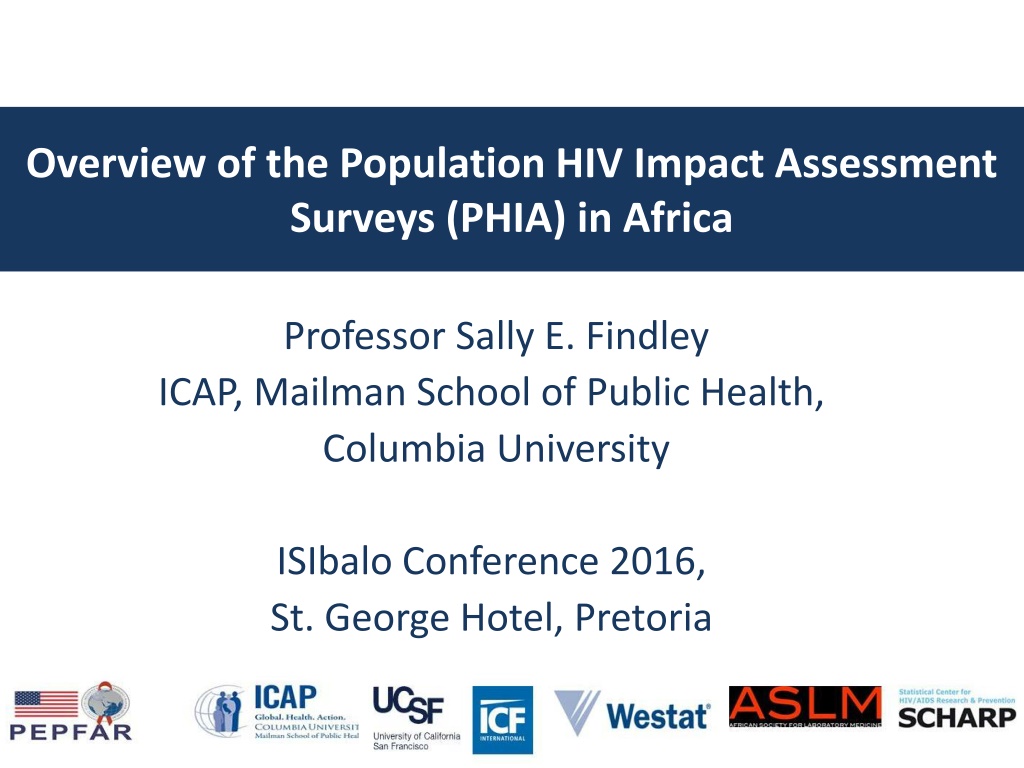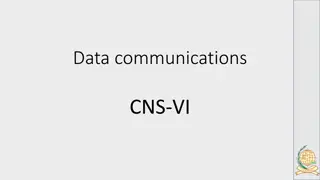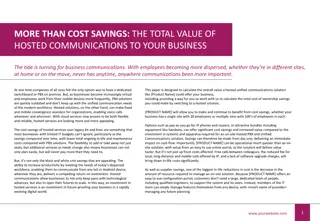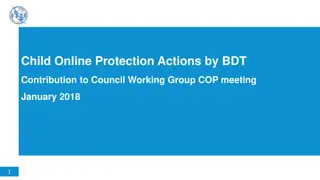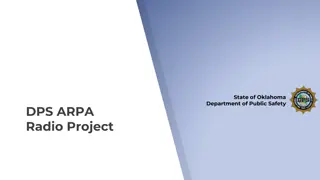Strategic Communications Approach for the PHIA Project in Africa
The Population HIV Impact Assessment Surveys (PHIA) in Africa Project focuses on strategic communication materials for global and country-level audiences, acknowledging PEPFAR as the donor and ICAP as the project lead. The communication strategy includes branding requirements, templates for various materials, and logos of relevant partners. The project aims to raise awareness, highlight key objectives, and differentiate PHIA from other surveys. Graphic treatments and clearances ensure proper representation in communications.
Download Presentation

Please find below an Image/Link to download the presentation.
The content on the website is provided AS IS for your information and personal use only. It may not be sold, licensed, or shared on other websites without obtaining consent from the author. Download presentation by click this link. If you encounter any issues during the download, it is possible that the publisher has removed the file from their server.
E N D
Presentation Transcript
Overview of the Population HIV Impact Assessment Surveys (PHIA) in Africa Project Communications Acknowledgement & Logos Through the PHIA Project, a range of strategic communication documents, materials and products will be developed for both global and country-level audiences. Materials will acknowledge PEPFAR as the donor, ICAP as the project lead, and the relevant project partners and co-sponsors. No project logo will be created for this project; however, a graphic treatment of the project name will be developed for public purposes. The addition of a CDC logo will be included, with CDC s Professor Sally E. Findley ICAP, Mailman School of Public Health, Columbia University permission and clearance. As needed, additional local partner logos may be included, as a courtesy. For materials developed for a global audience, the following logo lock will be used. This will be updated once clearance is received for use of the CDC logo. Project Communications Acknowledgement & Logos Through the PHIA Project, a range of strategic communication documents, materials and products will be developed for both global and country-level audiences. Materials will acknowledge PEPFAR as the donor, ICAP as the project lead, and the relevant project partners and co-sponsors. No project logo will be created for this project; however, a graphic treatment of the project name will be developed for public purposes. The addition of a CDC logo will be included, with CDC s permission and clearance. As needed, additional local partner logos may be included, as a courtesy. For materials developed for a global audience, the following logo lock will be used. This will be updated once clearance is received for use of the CDC logo. ISIbalo Conference 2016, St. George Hotel, Pretoria For materials developed for country-specific purposes, the logo presentation will reflect the local PEPFAR branding requirements, co-sponsoring Ministry of Health and relevant project partners. For example: For materials developed for country-specific purposes, the logo presentation will reflect the local PEPFAR branding requirements, co-sponsoring Ministry of Health and relevant project partners. For example: Donor Branding All materials will reflect the PEPFAR branding requirements for international and local audiences. The required PEPFAR attribution text will also be included: This project is supported by the President s Emergency Plan for AIDS Relief (PEPFAR) through CDC under the terms of cooperative agreement #1U2GGH001226. The contents are the responsibility of ICAP and do not necessarily reflect the views of the United States Government. Donor Branding All materials will reflect the PEPFAR branding requirements for international and local audiences. The required PEPFAR attribution text will also be included: This project is supported by the President s Emergency Plan for AIDS Relief (PEPFAR) through CDC under the terms of cooperative agreement #1U2GGH001226. The contents are the responsibility of ICAP and do not necessarily reflect the views of the United States Government. Materials Templates To ensure consistency across all strategic communications, ICAP will develop project-specific branded templates for preliminary and final survey reports, briefs, PowerPoint presentations, and conference posters. All project partners are required to use these in the development of materials. Materials Templates To ensure consistency across all strategic communications, ICAP will develop project-specific branded templates for preliminary and final survey reports, briefs, PowerPoint presentations, and conference posters. All project partners are required to use these in the development of materials. May 2015 May 2015
Objective of this presentation Rationale, objectives, and design of the Population HIV-Impact Assessments in Africa ( Sally Findley) How PHIA differs from and complements DHS surveys assessment of HIV prevalence The importance of biomarker data in the PHIA surveys A PHIA Road Map for African Demographers, and why you should be on that road
HIV epidemic in Africa: Progress in last 10 years 25 million people in Sub-Saharan Africa are living w. HIV Large regional variations in HIV prevalence, from 27% in Swaziland down to 0.5% in Senegal. 1.5 million new HIV infections per year (2013), with 40% of new infections among young women 15-24 12.9 million of those infected are on ART, vast increase in the last 10 years.
Rapid increases in ART coverage 15 million 12.9 Number receiving ART Projected Trend 10 million 5 million African Region 2003 2013 Source: Global AIDS Response Progress Reporting (WHO/UNICEF/UNAIDS)
What have been the drivers behind this increase? A dramatic increase in HIV Counseling and Testing (HCT) and reduction in HIV-related stigma Establishment of an integrated continuum of care from HTC through support for adherence, Expansion of ARV treatment to persons with less advanced disease (CD4<500 instead of <350) International donor support for HIV prevention, care, and treatment programs. Global Fund partners with local governments to provide HIV treatment services. PEPFAR supports free medications to 1 out of 3 Africans on ART
Continuum of Care and Impact: Coverage and Quality in Facilities McNairy, El-Sadr AIDS 2012
Ending new infections by 2030: Only if 90-90-90 by 2020
Need to target HIV program effort Can not reach 90-90-90 unless we can document achievements towards these targets Programs should be targeted towards regions and populations groups with low uptake including high risk groups Need to target communities/districts with high prevalence rates Groups not attaining each of the 90-90-90 targets may differ Decisions about to whom and where to target specific HIV program components need to be informed by detailed and current data.
CAN DHS+ ADDRESS THESE PROGRAM PLANNING NEEDS?
What we can learn about HIV from DHS HIV prevalence: National, by age, and urban/rural Access and use of HIV/AIDS services: HIV counseling and testing HIV/AIDS care and support services Antiretroviral medications Prevention of mother-to-child-transmission Post-exposure prophylaxis HIV knowledge, attitudes and Behaviour Knowledge of HIV prevention methods High risk sex in last 12 months Condom use HIV in pregnancy
Limitations of the DHS+ for Program Planning National prevalence only, with information only for basic demographic categories (gender, age, urban/rural) Prevalence estimate is subject to testing bias (unknown more likely to refuse) Small sample size limits the detailed analyses that can be made of subpopulations and their access and use of HIV- related services HIV testing only for adults 15-49, only AIS has information on children or older adults ART treatment and adherence measured only by self- report No return of results to respondents , so does testing does not link to awareness of status and care
Population HIV Impact Assessment: The PHIA Project PHIA Project Aim: Provide critical information needed to develop targeted HIV prevention and treatment programs which can help countries reach the 2020 goal of 90-90-90. PHIA Project Goals: Describe the epidemic in sufficient detail to inform HIV program planning in specific PEPFAR-supported countries Build capacity bystrengthening the workforce and infrastructure needed in targeted countries to design, conduct, analyze and disseminate results of PHIAs
PHIA Survey Objectives: Overview To estimate national HIV incidence among adults age 15-64 To estimate subnational prevalence of viral load suppression [HIV RNA <1000 c/ml] among adults age 15-64 To estimate national prevalence of HIV among children under age 15 years To estimate the 90-90-90 levels at national and subnational levels To identify practice of HIV prevention behaviors among high-risk groups
Similarities of DHS and PHIA Use of a generic protocol, questionnaires, and analysis/report template Multi-agency sponsorship of the survey Population-based household survey Cross-sectional, nationally representative Household and individual questionnaires Reports include basic demographic variables National and urban/rural HIV prevalence estimates, by age and gender
Key differences between DHS and PHIA DHS PHIA 3000 HH, 5-10,000 indiv. No children tested for HIV HIV rapid test only without return of results No viral load, CD4, EID, ARV metabolite or growth monitoring May not have detailed HIV program options in survey 15,000 HH, 30,000+ indiv. Children tested HIV rapid test + lab confirmation, w. return visit if discrepant results Testing and counseling at home for HIV, also syphilis, Hepatitis B Respondents get test results Full HIV continuum of care included
Samples powered to assess national incidence and viral load at subnational levels: Malawi and Zimbabwe examples Malawi: Zimbabwe: 500 EA s ~ 25-30 HH/EA 15,000 households Adults 15-49: 19,845 Adults 50-64: 2,995 Children 0-14: 10,988 Total Indivs: 33,828 500 EA s ~ 25-30 HH/EA 15,000 households Adults 15-49: 16,650 Adults 50+: 4,509 Children 0-14: 7,309 Total Indivs: 28,468
Adult/Adolescent Interview Question Modules Finding out who the participant is Modules: Background, Marriage Asking about the participant s children Modules: Reproduction, Children Starting to get more personal Modules: Male circumcision, Sexual activity, Violence Talking about HIV Modules: HIV testing, HIV support, care and treatment Other health issues Modules: Tuberculosis, Hepatitis B, Syphilis Cultural context Modules: Gender norms, Violence
PHIA: Biomarkers are Key! HIV biomarkers: HIV rapid testing and CD4 in the home w. immediate return of results HIV RNA (viral load suppression) HIV recency assays to measure HIV incidence (infection in the past year) Drug resistance/ ARV metabolite analyses Optional biomarkers: Hepatitis B, syphilis
PHIA Project: Countries TUNISIA MOROCCO ALGERIA WESTERN LIBYA Expected Year of Implementation EGYPT SAHARA MAURITANIA MALI NIGER ERITREA SUDAN SENEGAL 2015 2016 2017 CHAD THE GAMBIA DJIBOUTI BURKINA GUINEA BISSAU GUINEA BENIN TOGO NIGERIA ETHIOPIA COTE SOUTH SUDAN CENTRAL AFRICAN SIERRA LEONE D IVOIRE GHANA REPUBLIC LIBERIA CAMEROON SOMALIA DEMOCRATIC REPUBLIC KENYA EQUATORIAL GUINEA REP. OF THE UGANDA OF THE CONGO GABON CONGO RWANDA BURUNDI TANZANIA ANGOLA MALAWI ANGOLA HAITI ZAMBIA MOZAMBIQUE ZIMBABWE NAMIBIA BOTSWANA SWAZILAND LESOTHO SOUTH AFRICA
What we hope to learn from PHIA Summary Population HIV impact assessments will provide information on the HIV epidemic among adults and children in 12 severely affected African countries Will assess reach and quality of national and regional treatment service cascades and guide use of resources and future efforts to control the epidemic Repeating surveys every 5 years can allow countries to assess the impact of their programs on attaining 90-90-90 goal.
What YOU can learn about PHIA at ISIbalo : The PHiA Block led by Graham Kalton and Sally Findley Walk through the complexities of the PHIA sample design Learn the details of wieghting and variance estimation Identify the special strengths of the PHIA data Have your creativity sparked in developing innovative research questions and hypotheses Dive into the PHIA questionnaires and data dictionary to plan an analytic sequence with PHIA variables Learn how to specify possible multivariate models Appreciate the importance of linking analyses back to programs
PHIA ISIbalo Sequence Road Map Monday, 12 00 13 00 : Introduction to PHIA surveys Monday, 14 00 15 30 : PHIA sample design Monday, 15 45-17 15: Formulating Innovative research questions with PHIA data Tuesday, 11 30 13 00: Analysis plans for PHIA data Tuesday, 9 30 11 00: PHIA Weighting & Variance Estimation Tuesday 15 45 17 15: Specifying multivariate models Wednesday , 9 30 11 00: Mentored support to groups on presenting their PHIA research proposals Wednesday, 15 45-17 15: Optional PHIA sequence groups present their research proposals
PHIA data is useful only if you use it! We want you to come to the PHIA sequence to: Get excited about the PHIA surveys Tap into your creativity Emposer you to be a leader with the other PHIA team members in your country Talk to others about PHIA surveys and form PHIA analysis teams Be ready to start analysis as soon as the data are released
